#1930s german theatre
Text
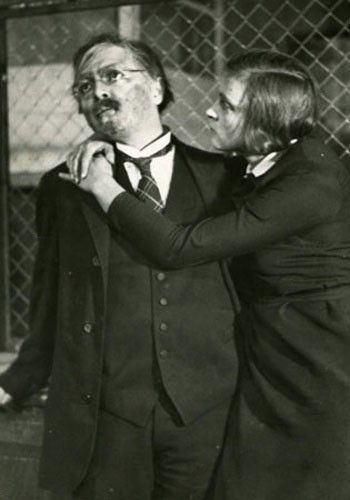
Peter Lorre as the Pawnbroker in Georg Kaiser’s Nebeneinander (Side by Side, September 1931), with Ilse Fürstenberg.
Peter’s “facial expressions gave, according to one reviewer, ‘good insight into one driven by demons.’” Source
Peter was so transformative. When you contrast even just this picture to his other 1931 works like “M” and “Die Koffer des Herrn O.F.”, he’s really quite astounding in his versatility.
More about the play: “With this play, [German dramatist] Kaiser moved away from the Expressionism of his previous works. Utilizing a more rounded characterization and more realistic curt, comic dialogue to tell a light-hearted story of an idealistic pawnbroker caught up in the hyperinflation afflicting Germany at the time (the currency stabilization came a fortnight after the play opened), the play inaugurated the 'new sobriety' (Neue Sachlichkeit) in the drama.” Wiki
#peter lorre#Nebeneinander#peter lorre theatre#peter lorre stage#peter lorre play#ilse furstenberg#il mustacchio#1930s german theatre#german drama#wish we had more pictures of him in this play
12 notes
·
View notes
Note
For the people that thought that Pomni was a nutcracker:
This, is a Nutcracker

According to German folklore, nutcrackers we given as keepsakes to bring luck to the family and protect the home. It is said that they represent strength and power and watches over the family keeping evil spirits and danger away.
They originate from ancestral dining customs where unusual, novelty nutcrackers were part of dining entertainment during the dessert course. It would generate fun conversation whilst tucking into their final course which could include pecans and hazelnuts.
Many of the early designs of nutcrackers were of birds, animals and people. It wasn’t until the 1600’s and 1700’s that they took the shape of kings and soldiers that we are familiar with today!
Nutcrackers were mainly popular in Germany to begin with, and were crafted in the Erzgebirge mountain regions.
It wasn’t until the 1800’s that this tradition was known worldwide from the release of the Tchaikovsky ballet ‘The Nutcracker Suite’ in 1892.
Many of us will have heard of this ballet and may treat ourselves to a trip to the theatre to see it over Christmas. The story of this production first came from the novel ‘The Nutcracker and the king of Mice’ by E.T. Amadeus Hoffman in the late 1700’s/early 1800’s, and is probably where we recognise the Christmas nutcracker from the most. The ballet was debuted in 1892 in St. Petersburg and is an ever popular festive treat for young and old worldwide due to its Christmassy theme.
From this point on, the ballet and German nutcracker figure have become well known around the world, and fans have demanded high quality German nutcrackers ever since. This therefore was where the nutcracker gained its popularity every Christmas time!
https://www.ukchristmasworld.com
This, is ventriloquist doll

Ventriloquism is an act of stagecraft in which a person (a ventriloquist) speaks in such a way that it looks like their voice is coming from a different location, usually through a puppet known as a "dummy".
Ventriloquism got its start as a religious practice amongst the Ancient Greeks and Romans. The name, in fact, comes from the Latin words for “to speak from the stomach." The Greek phrase for ventriloquism was gastromancy. Ancient peoples thought that noises produced by the stomach were the voices of the dead, which could be interpreted by the ventriloquist.
During the 18th century, ventriloquism became less spiritual and more of a performance art. It gained popularity as an act at traveling fairs. The earliest records related to ventriloquism date back to 1753 in England. The father of modern ventriloquism is considered to be Fred Russell, who began a stage show in London in 1886 and developed the now-familiar technique of using a doll to engage in back-and-forth conversation.
Edgar Bergen popularized a new form of comedic ventriloquism in the 1930s with his favorite dummy, Charlie McCarthy. Over the years, there have been many famous entertainers associated with ventriloquism, including Jeff Dunham and Shari Lewis.
If you've ever tried to “throw" your voice to imitate a ventriloquist, you know it's not the easiest technique to learn. Most ventriloquists perform with their lips slightly separated to allow sounds to emanate from their mouths without moving their lips. This is easy for some sounds and more difficult for others.
For example, the sounds of the letters f, v, b, p, w, and m can be particularly difficult, because they involve the lips meeting to help form the sounds. Professional ventriloquists learn to make these sounds by replacing them with other, similar sounds and speaking quickly enough for listeners not to notice.
Fortunately for ventriloquists, the human ear is not great at locating the source of a sound without visual or other cues. Therefore, if a ventriloquist can keep from moving his lips, it's very easy to fool the human ear into believing the sound is coming from the moving mouth of the ventriloquist's dummy!
There's more to ventriloquism than simply not moving your lips, though. You also have to learn to change your voice so that it sounds different than your normal voice. Doing so allows you to have a conversation with your dummy. Professional ventriloquists develop many different personalities for different dummies, and each one requires a unique voice and way of speaking.
https://wonderopolis.org/wonder/what-is-a-ventriloquist#:~:text=Ventriloquism%20got%20its%20start%20as,phrase%20for%20ventriloquism%20was%20gastromancy.
There you have it folks! If you have more questions, you're free to go to my blog and ask away! ^^
^^
135 notes
·
View notes
Text
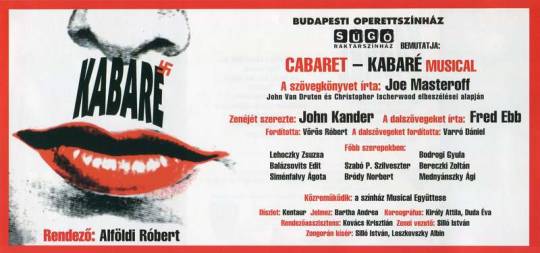
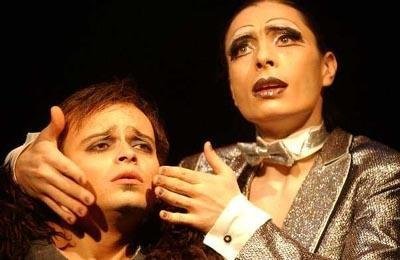




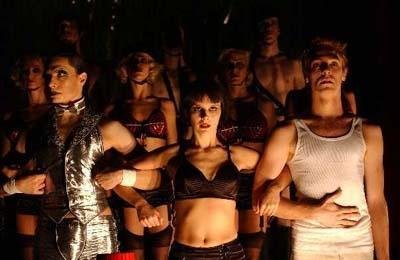

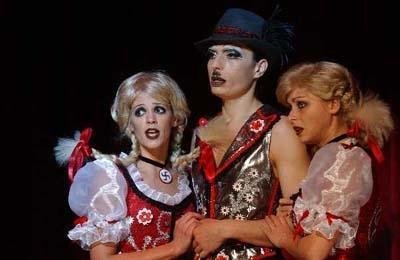
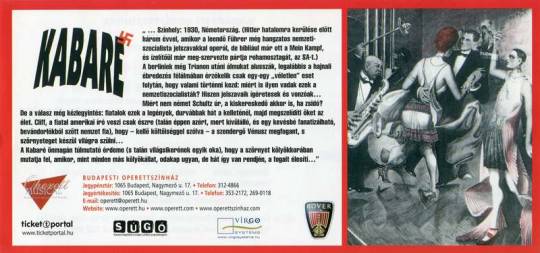
For the lovely @neednottoneed, with thanks for all the work they have done for our European musical fandom. Nagyon szépen köszönöm!
Images from Budapesti Operettszínház's 2002 production of Cabaret, starring Szilveszter Szabó as the Emcee, Edit Balázsovits as Sally Bowles, and Zoltán Bereczki as Cliff Bradshaw.
This was a fantastic production with lots of queer overtones, directed by openly-gay Hungarian theatre legend Róbert Alföldi. Having seen both in person, I found it comparable to the concurrently running Broadway production at the Roundabout Theatre.
English text of the advertising flyer pictured at the top and bottom:
"The setting is 1930, in Germany. (It is three years before Hitler assumed power: at this point, the Führer-to-be has used resounding National Socialist slogans, written Mein Kampf as a Bible for his movement, and organized the SA, his party's paramilitary force.) The people of Berlin have been asleep since the Treaty of Versailles or barely beginning to stir at dawn. Based on 'isolated incidents,' Berliners are starting to sense that something is happening: why are these National Socialists so wild? After all, their slogans are so promising and attractive. Why isn't Herr Schultz, a small-business owner, considered German if he is Jewish? At the moment the answer is a shrug: these lads are still young; if they are a bit rough around the edges, life will straighten them out. Only Cliff, a young American writer notices - perhaps because as an outsider and the son of a nation woven of immigrants, he is more difficult to fanatize - that, poetically speaking, the sleeping Venus has conceived and is about to give birth to a monster. The unique merit of 'Cabaret', reaching well beyond its own meaning - and possibly the reason for its worldwide success - is that it presents this monster as a cub. Like all young animals, this cub snaps occasionally, but that's only natural - it is merely sharpening its teeth."
#cabaret#cabaret musical#cabaret budapest#kabaré#budapesti operettszínház#budapest operetta theatre#szabó p. szilveszter#szilveszter szabo#balázsovits edit#edit balazsovits#bereczki zoltán#zoltan bereczki#alföldi róbert#robert alfoldi#emcee cabaret#sally bowles#cliff bradshaw#musical theatre#hungarian musicals#magyar musicalek#sparkly hungarian fandom#sparkly hungarians
80 notes
·
View notes
Text
Walle: The Graffiti Bug
Walle is the Overlord over the Art industry, specifically painting and scenic art, and is part of the Theatre Overlords lead by The Puppeteer.

Walle grew up in Vienna, Austria during the 1920s and 1930s. He was a rather sickly child, with a very weak immune system and often being neglected by his family.
He almost never left his home or even go outside, meaning he had no friends growing except for the many rodents and bugs that would enter his rooms. His best friend being a stag beetle.
However, he would entertain himself by drawing and painting with material he can find. Even his family dubbed his activities as “wasteful and useless”, he would continue to draw anything and anyone that he saw either from his room or outside his window.
However, during the 1930s, he was diagnosed with schizophrenia and was placed under the care of the Am Spiegelgrund Clinic in Vienna, Austria. While there, he was bullied and mistreated by the other patients and staff members. To continue his artistic passion, he would use food, clothes, dust, and even his own blood, hair, and nails to create art. However, while being punished by a nurse, Walle lost control and attacked the nurse, which he doesn’t remember much off except that he was holding a knife and the nurse was lying in a pool of her own blood.
Because of this incident, he was locked his room, wearing a straitjacket and shackles around his ankles, preventing him from even walking around his room.
During this time, Austria was under Nazi rule, where a new program was established to “handle” the mentally ill/physically defective children, called Aktion T4. This program lead to over 700 children to be euthanized at the Am Spiegelgrund Clinic.
In December of 1941, Walle was sent to be euthanized by a lethal injection of phenol, and soon became one of the many unfortunate children to fall to this program.
After arriving in Hell, he was greeted by violence of the sinners, and tried to hide to protect himself. However, he was found by The Puppeteer, who saw his potential artistic talent when he was alive. The Puppeteer offered him a deal, they would bring out the artistic talent dormant within him, give him the energy and motivation to create massive masterpieces in just hours (or days depending on the size of project), and offer to protect him from all the dangers within Hell. However, in exchange, his soul is owned by the Puppeteer, having to follow their command when needed. Due to his young age, and being taught that he was of low value, he accepted The Puppeteer’s offer.
Due to being isolated for most of life, he doesn’t really know how to socialize, mainly keeping to himself unless he’s addressed, which then he only responds with one word to short sentences. He does get along with Zelyezda, almost viewing her as a mother. She was the first to greet and comfort him whenever he felt stressed or had a nightmare. After the Puppeteer invited Charlie and the gang to watch one of their performances, he met with Charlie, but barely paid any attention to her. It was Zelyezda who told him about what Charlie is trying to accomplish at the Hazbin Hotel. After learning about the possibility of redemption and going to Heaven, she urges him to go there and try to be redeemed, wanting to both give him a better afterlife and to break free from the Puppeteer’s control.
Design
His name is the combination of the German words: “Wanze” meaning Bug and “Falle” meaning Trap.
He is around 4ft tall (4ft 6in including his horns), making him the shortest of the Theatre Overlords and around the same height as Niffty who’s around 3ft 9in-4ft.
His horns resemble that of a stag beetle, specifically an European Stag Beetle. This is supposed to represent both his “best friend” growing and the saying “small but mighty”
Regarding the colors, I wanted him to similar to a corpse during decomposition, which the body turns pale and slightly green.
His very frail and slim, having a general humanoid figure, with the exception of the horns, lack of nose, and deathly cold skin. The red x on his arm represents where he got the lethal injection, with veins representing the phenol.
Unlike the other Theatre Overlords, he doesn’t have any physical shackles. This is due to him being in the “free trial” of The Puppeteer’s deal. This gives him a false sense of freedom and The Puppeteer feels that shackles aren’t needed to control him, unless he severely misbehaves.
Here is a basic reference without the dress:

2 notes
·
View notes
Text
There's a song used in the movie The World's End, final instalment of the Cornetto Trilogy, called Alabama Song (or sometimes Moon of Alabama) as performed by the band The Doors in 1967 and it kills me I have no excuse ever to tell people it's a cover of a song from a 1930's opera called The Rise and Fall of the City of Mahagonny about a city built in the desert for the express purpose of gambling and prostitution and the subsequent arrest and trial of one of their patrons, and was composed by Kurt Weill and written by playwright Bertolt Brecht, a German playwright who wrote a lot of crazy shit and who theatre students almost universally cannot stand
#the worlds end#the cornetto trilogy#bertolt brecht#i'm watching the movie rn which is my only excuse to talk about it#also i know this because i ran lights for a production of mahagonny in school#and that particular song was great#no one understood the plot except us because we had to watch it so many times lmao
10 notes
·
View notes
Text
THIS DAY IN GAY HISTORY
based on: The White Crane Institute's 'Gay Wisdom', Gay Birthdays, Gay For Today, Famous GLBT, glbt-Gay Encylopedia, Today in Gay History, Wikipedia, and more …

1791 – France (Revolution) is the first Western European country to decriminalize homosexual acts.


1882 – Karol Szymanowski, the Polish composer, was born (d.1937). In his autobiography, My Life and Loves, the pianist Artur Rubenstein speaks of his friendship with the important Polish composer, Karol Szymanowski, who was Gay. Rubinstein speaks of a wealthy friend and admirer who had invited the composer several times to visit Italy. "After his return," Rubenstein writes, "he raved about Sicily, especially Taormina. 'There,' he said, 'I saw a few young men bathing who could be models for [the famed lover of Hadrian] Antinous. I couldn't take my eyes off them.'" Rubenstein doesn't mention that Szymanowski had been visiting the isle of Wilhelm von Gloeden, and one wonders, in fact, and whether the German photographer was Szymanowski's wealthy friend.
Szymanowski was born to a wealthy land-owning family of the Polish gentry in the present-day Ukraine. From 1901 he attended the State Conservatory in Warsaw, of which he was later director from 1926 until retiring in 1930. Musical opportunities in Russian-occupied Poland being quite limited at the time, he travelled widely throughout Europe, North Africa, the Middle East, and the US.. These travels, especially those to the Mediterranean area, provided much inspiration to the composer and aesthete.
During these trips he also wrote poetry and his novel Efebos, parts of which were subsequently lost in a fire in 1939. He explored religious and homosexual themes in the novel and it was translated by him into Russian and given as a gift in 1919 to his partner Boris Kochno.


1976 – Carlo Masi is the screen name of Ruggero Freddi, an Italian mathematics lecturer, and former gay pornographic film actor.
Freddi was born in Rome in 1976 to a "poor" family. His parents divorced when he was three years old. At the age of 14, he began to work out at a local gym, practicing bodybuilding assiduously. In 2002, when he was about to complete his first cycle of study at the Sapienza University of Rome, he moved to Canada, and subsequently to New York.
In 2003, Masi completed a Master of Science (MSc) degree in computer engineering at the Sapienza University of Rome and worked in an artificial intelligence laboratory.
In 2004, after being contacted by a Colt Studio Group (CSG) recruiter, he made his debut in the gay pornography industry participating in his first porn movie, Big N 'Plenty. After his debut, he signed an exclusive model contract with CSG. He has always promoted safe sex, fraternising with the Italian LGBT community.
In 2006, he was selected to appear on the cover of COLT 40, a coffee table book published to celebrate the fortieth anniversary of the production company.
In 2007, Masi and his future husband, Adam Champ (Gustavo Leguizamon), were selected to appear on the cover of the Damron 2007 Men's Travel Guide.

In 2008, CSG and Calaexotic released a dildo reproduction of Masi's penis. That same year, he was named the first and only Colt Man Emeritus and his contract was extended to life time one. In 2008, Masi and Champ, were selected to appear on the cover of Adam Gay Film & Video Directory Magazine.
Following a disagreement with Colt in 2009, Masi retired from the pornographic industry.
After working in the theatre, Masi decided to return to the Sapienza University of Rome. There he earned a Bachelor of Science degree (cum laude) in mathematics, with a score of 110/110 and then a Master of Science degree (cum laude) in mathematics with a score of 110/110. In 2020, he completed a Ph.D. in Mathematical Models for Engineering, Electromagnetism and Nanosciences at Sapienza University of Rome focusing on the application of Morse theory to a Dirichlet problem traced back to Poisson equations.
In 2017, an article published by la Repubblica brought to light his past as a porn actor causing a media frenzy. The story was picked up by numerous newspapers around the world.
In 2015, he married Prince Giovanni Fieschi Ravaschieri Del Drago in Porto. In 2016, he became his widower.During his participation at Pomeriggio Cinque, an Italian news program, he proposed to his partner, Gustavo Leguizamon. The civil union was celebrated on May 4, 2018, and was broadcast live on Pomeriggio Cinque.

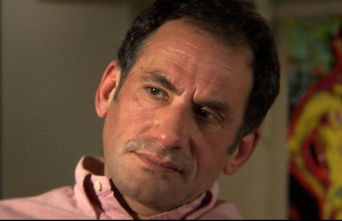
1955 – Richard Berkowitz is a gay American author and activist best known as an early advocate of safe sex in response to the AIDS crisis among gay men in the 1980s.
Berkowitz was born to Jewish parents and raised in New Jersey. While in college, he organized what he believes was the first gay rights protest in the state, demonstrating against an anti-gay effigy hung by the Delta Kappa Epsilon fraternity. After college, Berkowitz moved to New York City in 1978 or 1979, earning a living as a self-described S&M hustler.
Even before AIDS was recognized as a syndrome, Berkowitz became concerned about protecting his clients, many of whom were married, from sexually transmitted diseases. He met physician Joseph Sonnabend and became a patient, learning from Sonnabend the practices for risk reduction that would later become known as safe sex. His early work with Sonnabend and singer and activist Michael Callen noted behaviors including drug use, multiple sexual partners, and unsafe sexual practices in the gay community for transmission. These claims were considered controversial by early leaders of Gay Men's Health Crisis, such as Larry Kramer, and many activists took issue with the language of their message and its implications.
The 1983 pamphlet "How to Have Sex in an Epidemic: One Approach" by Callen and Berkowitz (in consultation with Sonnabend) is widely considered the first sex-positive guide to practicing safe sex.
Berkowitz himself tested positive for HIV in 1984 but was able to avoid taking any anti-viral drugs until 1995.
Berkowitz is the subject of the 2008 documentary Sex Positive directed by Daryl Wein and winner of the 2008 OUTFEST Grand Jury Prize for Best Documentary.

1967 - A New Mexico appellate court rules that cunnilingus is prohibited by the state's sodomy law.

1997 – Annie Proulx’s short story Brokeback Mountain is published in this week’s issue of The New Yorker. The story, later turned into a hit movie, depicts the complex romantic and sexual relationship between two men in the American West from 1963 to 1981. In 2007, the composer Charles Wuorinen approached Proulx with the idea of turning her short story "Brokeback Mountain" into an opera. The opera of the same name with a libretto by Proulx herself premiered January 28, 2014 at the Teatro Real in Madrid, to mixed reviews.


3 notes
·
View notes
Text
The great international beaches, 1930

Ilustração, No. 112, August 16 1930
German dancers Grete Wahren and Berta Scharren, of the Italian Lido; and Spanish singer Conchita Supervia, of the Royal Theatre of Madrid.
2 notes
·
View notes
Text

Here a portrait of Florence Austral, from 1929.
One of the world’s great Wagnerian sopranos was born Florence Mary Wilson in the humble Melbourne suburb of Richmond on 16 April 1892. From 1903, when her mother remarried, she took the name Florence Fawaz. After some basic voice training she won several prizes in the 1913 Ballarat South Street competitions and was accepted as a pupil of the respected Elise Wiedermann, first at Fritz Hart’s Albert Street Conservatorium, and later at the University of Melbourne Conservatorium. By 1919 she was ready to undertake further studies in New York, but not before she had been engaged by J.C. Williamson Filmsto sing between silent movie presentations at the Paramount Theatre in Bourke Street. Her associate artist was New Zealand born flautist John Amadio.
New York proved professionally disappointing, so the young soprano tried her luck among the many Australian singers in London. There, in September 1920, she made her professional debut singing at a fashionable restaurant. Adopting the stage name ‘Florence Austral’ in tribute to her homeland, she made her operatic debut as Brünnhilde in Wagner’s Die Walküre with the British National Opera Company at Covent Garden on 16 May 1922. Later in the season she also sang Brünnhilde in Siegfried and Götterdämmerung. She made the first of her many recordings in September, and then toured Britain with the BNOC, singing the Wagner repertoire and the title role in Aida. She sang in concerts and continued her studies at the London School of Opera.
Parts of her performance in Siegfried at Covent Garden on 11 January 1923, conducted by Eugene Goossens, were broadcast ‘live’ by the BBC. On 20 January she shared the stage with Melba in a gala finale to the BNOC’s season and in June she sang Tristan and Isolde for the first time.
In 1925 Austral sang in the United States, but her auditions for the Metropolitan Opera were unsuccessful, probably because of her increasing weight. She returned to London, where she and John Amadio married. During their honeymoon in the USA, Austral made her New York debut at Carnegie Hall on 2 January 1926.
She visited America again in 1927, 1928 and 1929, singing in concert and in Aida, Die Walküre and Götterdämmerung with the Philadelphia Civic Opera Company. She joined tenor Richard Crooks in an all-Wagner concert at the Metropolitan Opera House on 27 January 1929. Back in London she sang another Walküre at Covent Garden. In 1930 she and Amadio made a triumphant ‘homecoming’ concert tour of Australia under the management of E.J. Carroll. That year she also toured South Africa, sang Wagner with the Städtische Opera in Berlin – an engagement that was curtailed because of her imperfect German – and commenced another American tour. In 1932 she sang in the Netherlands and returned to Covent Garden in Tristan and Isolde. In New York in January 1933 she was one of 1,800 performers in a bizarre presentation of Beethoven’s Choral Symphony in the vastness of Madison Square Garden.
In 1934 Austral and Amadio returned to Australia for a concert tour under the direction of a budding local entrepreneur, A.D.M. ‘Archy’ Longden. His advance manager, Madeleine Clarke, was said to be ‘the only female concert manager operating in the Commonwealth’. The beautifully designed and printed souvenir programmes were available with a range of coloured covers to harmonise with lady patrons’ gowns, and were bound with transparent glassine wrappers ‘to prevent any damage to white evening gloves.’
Austral, Amadio and their pianist, Raymond Lambert, attracted publicity wherever they went. Unfortunately their visit to Albury coincided with the grisly discovery of the mutilated corpse of a young woman. This was the start of the notorious ‘Pyjama Girl’ mystery, and flights of fancy tried to link the Austral party to the crime, even suggesting that Longden or Lambert may have been the murderer.
Austral then took her place as the star of Sir Benjamin Fuller’s noblest venture, his Royal Grand Opera Company, which was designed to complement the excitement generated by Melbourne’s centenary. The company debuted at the refurbished Apollo Theatre in Bourke Street on 29 September 1934 with Austral in the title role of Aida – her first appearance in opera in her homeland. Over the next months, in Sydney and Melbourne, she sang in Walküre, Tristan and Isolde and, for the first time, Tosca, The Flying Dutchman and The Pearl Fishers (its Australian premiere). Austral later undertook a series of recitals and opera broadcasts for the ABC. In 1936-37 she made her final United States tour.
Austral returned to Britain, but the musical landscape had altered: broadcasting had eroded concert audiences, and other dramatic sopranos had usurped her place at Covent Garden. Her voice had also lost much of its lustre and her technique had started to deteriorate. In 1938 she sang in Walküre and Cavalleria Rusticana for Sadler’s Wells and Il Trovatore and Der Freischutz for the Dublin Operatic Society at the Gaiety Theatre, Dublin. She sang Lohengrin there in 1939; it was her last appearance in opera. British concert engagements dwindled alarmingly; in 1945 she and Amadio returned to Australia.
When Austral sang at the 1946 Carols by Candlelight concert in Melbourne, her performance revealed the sorry state of her voice. She did not sing in public again. She taught at the University of Melbourne and helped with Gertrude Johnson’s 1948 National Theatre Opera seasons. In 1952 she accepted Eugene Goossens’ offer of a position at the new Newcastle Conservatorium. She resigned in 1959 and taught privately for a while, but by then she was in straightened circumstances and suffering from multiple sclerosis. Friends such as actor Max Oldaker rallied round and EMI reissued some of her greatest recordings. She died in virtual obscurity on 15 May 1968. Her husband, from whom she was estranged, had died in 1964 during rehearsals for a Melbourne concert.
The Newcastle Conservatorium has awarded an annual Florence Austral Memorial Scholarship since 1970.
#Florence Austral#Austral#soprano#dramatic soprano#Richard Wagner#Wagner#Covent Garden#opera#bel canto#aria#diva#prima donna#opera singer#operatic singer#operatic singing#operatic soprano#chest voice#classical music#music history#classical singer#classical singing#classical studies#classical#classical musician#musician#singer#music#photography
4 notes
·
View notes
Text
Ilustração, No. 112, August 16 1930
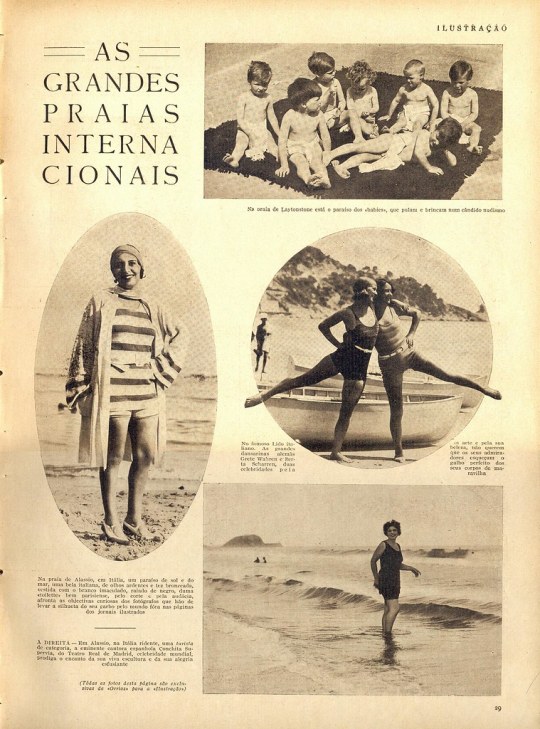
German dancers Grete Wahren and Berta Scharren, of the Italian Lido; and Spanish singer Conchita Supervia, of the Royal Theatre of Madrid.
3 notes
·
View notes
Text

Peter Lorre (third from left) along with Ludwig Stössel, Mathias Wiemann, Max Paulsen, and others in the play ''Voruntersuchung," (Preliminary Investigation) Renaissance Theater, Berlin (1930).
Peter played Bruno Klatte, reciter.
#peter lorre#bruno klatte#Voruntersuchung#1930s german theatre#peter lorre theatre#peter lorre stage
14 notes
·
View notes
Text
UNDER FIRE
1915
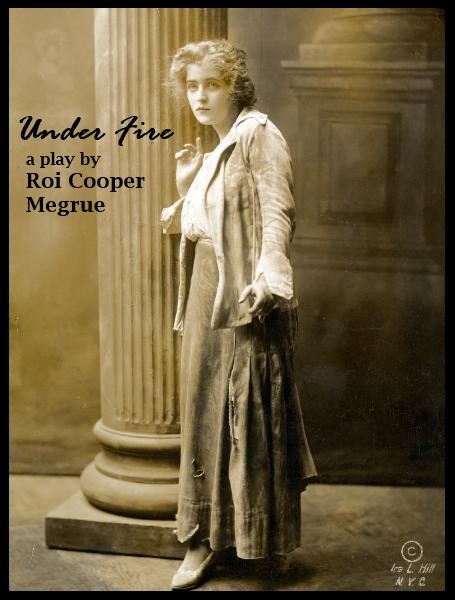
Under Fire is a play by Roi Cooper Megrue. It was originally produced by Selwyn & Company and co-directed by Megrue and its star, William Courtenay. The original production also featured Violet Heming (above), Frank Craven (who played an American reporter named Charlie Brown), and, in the ensemble, Edward G. Robinson.
The play was presented in London the previous season. At the time of production, the United States had not yet officially entered World War One (aka ‘The Great War’) which didn’t happen until April 6, 1917.
The play was billed as “a new play of today, tomorrow, and yesterday.”

This was the second of Megrue’s “Under” plays. The first was 1914′s hit Under Cover, and the third, and least successful, was 1916′s Under Sentence. All three were produced by Selwyn and Co. The first two were seen in Atlantic City featuring William Courtenay.

Megrue, however, denied that the use of the ‘Under’ titles was intentional. The plays are thematically unrelated. However, creating a third title containing ‘Under’ makes it difficult to claim it was not intentional.
"Under Fire" concerns itself with an adventurous and lovable young Irishman, (William Courtenay), who, finding himself in England at the beginning of the war after several years of foreign service, goes to Belgium with the first expeditionary force when England declares war. In England, he rediscovers the woman he loved, whom he had left years before because his poverty prevented him asking her to exchange her life in the most exclusive London society, where both her wealth and her charm placed her, for the nomadic existence of the wife of a young officer. By a striking chain of events, she finds herself In a position where she cannot accept his suit, nor tell him why, but she promises that in the great war game he is entering she will help him. The very circumstance which prevents her from becoming engaged to the Irish captain sends her into Belgium almost as soon as he goes. They meet, and to all appearances, are on opposite sides of the great struggle.
It was claimed that the company for the played number 150 with 50 speaking parts.
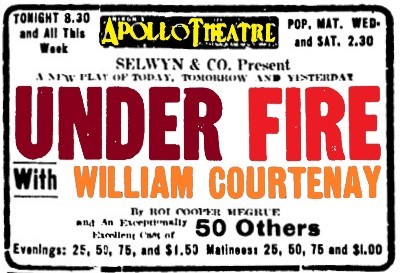
Under Fire premiered in Atlantic City at Nixon’s Apollo Theatre on the Boardwalk on May 24, 1915. Unusually, the play held an invited dress rehearsal for actor and managers who could not be away from New York City on its opening night.


On August 5th, the play was seen at the Broadway Theatre in Long Branch NJ.

Under Fire opened on Broadway on August 12, 1915 at the Hudson Theatre (141 West 44th Street).
About the Venue: The Hudson was bult in 1903. It was most often used as a TV studio in the 1930s, 40s, and 50s. In 1974, it was a blue movie theatre. In 1980, it became the Savoy, a rock club. In 1987, it received landmark status, so it was incorporated it into the adjacent Millennium Broadway Hotel as a conference center and auditorium. The venue re-opened as a legitimate Broadway theatre in 2017.

Like Under Cover, a novelization of the play was published in 1916, It was co-authored by Richard Parker, published by The Macaulay Company. The book was serialized for newspapers.
“In order to discourage the audiences at the Hudson Theater from taking sides during the performances of Roi Cooper Megrue’s ‘Under Fire,’ Selwyn and company have inserted a notice in the program requesting that no member in the audience indulge in any unpleasant demonstrations which might be offensive to others in the audience, or to those on the stage.” ~ BROOKLYN DAILY EAGLE

"’Under Fire’ may well be Judged by German sympathizers as out-and-out anti-German propaganda. With probably the best Intentions in the world, and with an apparent effort to be fair at least, Mr. Megrue has nevertheless moved a load of dynamite into the Hudson Theater and placed it under fire.” ~ BROOKLYN DAILY EAGLE
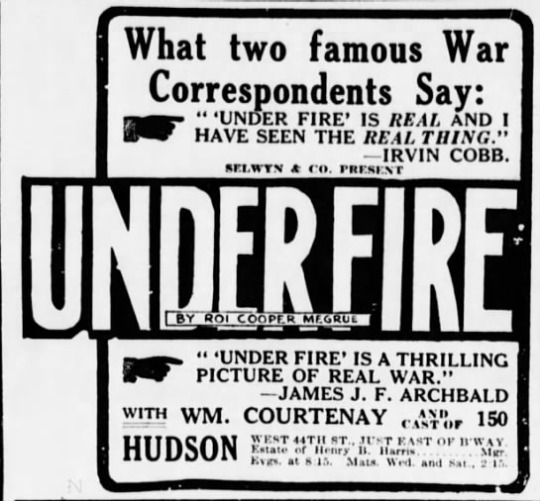
“’Under Fire’, while dealing with certain phases of the Great War, attempts to be neutral, although its characters being English, Belgian, French, and German, are naturally partisan.” ~ Samuel French Acting Edition of the Play, 1918

“[The trench scene] is a masterpiece of the stage architect. As one critic put it, ‘A sky brilliant with stars, a soldiers’ game of cards, the sentries on watch, the bursting of bombs and signal lights, and finally the aerial mine that ends all —Belasco never created anything more perfect.’” ~ BRETT PAGE, AUSTIN AMERICAN STATEMENT
Although Belasco was noted for his plays’ technical proficiency, he did not like Megrue’s writing. He must have changed his mind, however, because he produced Megrue’s play Seven Chances, which ran concurrently with the third ‘Under’ play Under Sentence in the second half of 1916.
The Broadway production of Under Fire ran for 129 performances, and then decamped to Boston’s Park Square Theatre. From there it embarked upon a tour of the North East: Massachusetts, New York State, and Pennsylvania.
In early 1916, a production opened in Sydney Australia at the Criterion Theatre.

In April 1916, the play was presented in Brooklyn, first at the Shubert, then at the Montauk.
On May 1, 1916 it was presented at Philadelphia’s Forest Theatre. The role of Charlie Brown, formerly played by Frank Craven, was taken by Frank Morgan. By this time, Megrue and Selwyn began planning production of their next Under play, Under Sentence. Also in 1916, Edward G. Robinson made his film debut. It would be the movies, not the stage, that catapulted the actor to fame. In 1973, he posthumously received an honorary Academy Award, accepted by his wife Jane.
#Under Fire#Roi Cooper Megrue#Under Cover#1915#Atlantic City#Broadway#Broadway Play#Edward G. Robinson#Frank Craven#Frank Morgan#Violet Heming#William Courtenay#World War One
2 notes
·
View notes
Text
Ok I’m gonna write about Cabaret at the Kit Kat Club so spoilers below
- ok so I’m kinda obsessed with Cabaret because we had to analyze the movie in English class and I was super moved by the context of the Nazis coming to power. I feel like any Great musical has this kind of dark historical context (les miz, hairspray, Evita.. ). I find Cabaret soooo intriguing especially because it’s pre WWII whereas most mainstream media is set during WWII
- omg so they turned the entire playhouse theatre into the Kit Kat club and when I entered through the basement they gave me a shot of schnapps. And it was like being in 1930s berlin it was soooo beautiful but in a dark and dirty way. And I walked into a bar with a pianist and clarinetist. And then there was a bar upstairs with dancers. And then there was a cocktail bar upstairs so I got a cocktail and went to watch the dancers until the show actually started and the dancers WERE AMAZING and so raunchy and in character the entire time and they were playing with the audience and dancing through the aisles throughout the night I wish I was on one of the tables at the front but they were £400 SERIOUSLY that’s fucking like $800 but idk now I’ve experienced it maybe it’s worth it????
- they added a storyline about the landlady and songs to go with it (I think it’s in the book? Haven’t read it). And it’s super moving because she falls in love very awkwardly with a Jewish man.
-they sing a song about a pineapple and it is adorable
- in the movie they hint at darkness but the turning point I think is when a little German boy sings Tomorrow Belongs to Me and then the men join in and you see their Nazi armbands. In the musical they had two versions of the song, one sung gently by the Emcee. And then there is an engagement party where a friend of the landlady takes off his coat and his Nazi armband is revealed and it’s such a Big moment. He learns that his friend is marrying a Jew and goes to leave, then a chorus girl sings the folk song to get him to stay. And he joins in and then the chorus joins in and it’s so powerful and TERRIFYING. I cried at this point because it was so moving.
- Sally Bowles’ last Cabaret performance is sooo sad. Actually this Sally was very stripped down, she performed mostly without a wig and dressed down. I think in the movie she still seems hopeful, in a self-deceiving sort of way. But here she had just given up.
- The second Wilkkommen was also terrifying, the Emcee was so angry and scary at this point. And all the cast dressed in plain brown suits. It made me so sad. Such a contrast to the movie. But I really loved how they played up the darkness of the story.
- The Emcee I think was definitely the star. Maybe because they took Sally out of a lot of their shared scenes in the movie. But he was just everything, raunchy, funny, dirty, provocative, scary. I love his character so much.
ANYWAY IM SO HAPPY AND SAD AND I WANT TO EXPERIENCE THIS ALL AGAIN 😭😭😭
1 note
·
View note
Text
MARK FRANKO

Lundi 29 avri 2024 à 19h (heure de Paris)
Monday April 29th 2024, 7pm (Paris time)
@ MSH, 16 – 18 RUE SUGER, 75006 (métro Odéon ou St – Michel)
Mark Franko est un historien de la danse de réputation internationale. Il a renouvelé notre compréhension de la danse baroque autant que de la performance et de la chorégraphie du XXe siècle dont il a étudié particulièrement les relations avec le champ politique et la constitution des collectifs. Depuis Dancing Modernism/Performing Politics en 1995, il a publié Dance as Text: Ideologies of the Baroque Body traduit en Français par les Éditions de l’Éclat sous le titre La danse comme texte : Idéologies du corps
baroque ; The Dancing Body in Renaissance Choreography: Kinetic Theatricality and Social Interaction (2022) ; The Work of Dance: Labour, Movement and Identity in the 1930s (2002) ; Martha Graham in Love and War : The Life in the Work (2012 )et, en 2020, The Fascist Turn in the Dance of Serge Lifar: Interwar French Ballet and the German Occupation. Il est aussi le co-éditeur de Acting on the Past: Historical Performance Across the Disciplines (2000).
En 2018 une anthologie de ses écrits a été publiée par Routledge :
Choreographing Discourses: A Mark Franko Reader qui permet de retrouver les nombreux articles qu’il a publiés dans Discourse, PMLA, The Drama Review, Res: Anthropology and Aesthetics, Theatre Journal… Mark Franko est professeur de Danse et président du département des Arts du Théâtre de l’Université de Californie, Santa Cruz. Mais Franko a aussi poursuivi une carrière de danseur et de chorégraphe, d’abord (1964-1969) dans le cadre du Studio for Dance, à New York, un bastion précoce de la danse post-moderne auquel il a consacré un livre, Excursion for Miracles: Paul Sanasardo, Donya Feuer, and Studio for Dance. Avec sa propre compagnie, NovAntiqua, fondée en 1985, il a travaillé le répertoire classique autant que la restitution des danses du Bauhaus par exemple. Son œuvre de chorégraphe a obtenu le soutien du National Endowment for the Arts, the Harkness Foundation for Dance, the Getty Research Center for the History of Art and the Humanities, the Zellerbach Family Fund and the New Jersey State Council on the Arts. NovAntiqua s'est produite au J. Paul Getty Museum (Malibu), au Berlin Werkstatt Festival, à la de la Torre Bueno Award Ceremony (Lincoln Center, New York), au Mueée d'Art de Toulon, à l'Opéra de Montpellier,au Lincoln Center Out-of-Doors Festival, aux Princeton University Theater and Dance Series, au Haggerty Art Museum (Milwaukee), et le ODC Theatre San Francisco.
[EN] Mark Franko is an internationally renowned dance historian. He has renewed our understanding of Baroque dance as much as of twentieth-century performance and choreography, whose relations with the political field and the constitution of collectives he has studied in particular. Since Dancing Modernism/Performing Politics in 1995, he has published Dance as Text: Ideologies of the Baroque Body, translated into French by Éditions de l'Éclat as La danse comme texte: Idéologies du corps baroque; The Dancing Body in Renaissance Choreography: Kinetic Theatricality and Social Interaction (2022); The Work of Dance: Labour, Movement and Identity in the 1930s (2002); Martha Graham in Love and War: The Life in the Work(2012 )and, in 2020, The Fascist Turn in the Dance of Serge Lifar: Interwar French Ballet and the German Occupation. He is also the co-editor of Acting on the Past: Historical Performance Across the Disciplines (2000). In 2018, an anthology of his writings was published by Routledge: Choreographing Discourses: A Mark Franko Reader, which brings together the many articles he has published in Discourse, PMLA, The Drama Review, Res: Anthropology and Aesthetics, Theatre Journal... Mark Franko is Professor of Dance and Chair of the Department of Theatre Arts at the University of California, Santa Cruz. But Franko has also pursued a career as a dancer and choreographer, first (1964-1969) with New York's Studio for Dance, an early bastion of post-modern dance to which he dedicated a book, Excursion for Miracles: Paul Sanasardo, Donya Feuer, and Studio for Dance. With his own company, NovAntiqua, founded in 1985, he has worked on the classical repertoire as well as the restitution of Bauhaus dances, for example. His choreographic work has been supported by the National Endowment for the Arts, the Harkness Foundation for Dance, the Getty Research Center for the History of Art and the Humanities, the Zellerbach Family Fund and the New Jersey State Council on the Arts. NovAntiqua has appeared at the J. Paul Getty Museum (Malibu), the Berlin Werkstatt Festival, the de la Torre Bueno Award Ceremony (Lincoln Center, New York), France's Toulon Art Museum, the Montpellier Opera, Lincoln Center Out-of-Doors Festival, the Princeton University Theater and Dance Series, the Haggerty Art Museum (Milwaukee), and ODC Theatre San Francisco.
Programmation et prochains rendez-vous sur ce site ou par abonnement à la newsletter : [email protected]
Pour regarder les séminaires antérieurs : http://www.vimeo.com/sysk/
Séminaire conçu et organisé par Patricia Falguières, Elisabeth Lebovici et Natasa Petresin-Bachelez et soutenu par la Fundación Almine y Bernard Ruiz-Picasso para el Arte
0 notes
Text
Birthdays 3.21
Beer Birthdays
Sampson Salter (1692)
William Worthington (1723)
Gabriel Sedlmayr (1772)
Anton Dreher Jr. (1849)
Pierre Celis (1925)
Iain Gately (1966)
Five Favorite Birthdays
Timothy Dalton; actor (1946)
Roger Hodgson; rock musician (1950)
Eddie James "Son" House; blues musician (1902)
Modest Mussorgsky; composer (1839)
Ayrton Senna; Brazilian formula 1 racer (1960)
Famous Birthdays
Matthew Broderick; actor (1962)
Peter Brook; film director (1925)
Solomon Burke; pop singer (1940)
James Coco; actor (1930)
Jean Baptiste Joseph Fourier; mathematician, physicist (1768)
Al Freeman Jr.; actor (1934)
Julio Gallo; winemaker (1910)
Cynthia Geary; actor (1965)
Walter Gilbert; chemist (1932)
Benito Juarez; Mexican politician (1806)
Francis Lewis; signer of the Declaration of Independence (1713)
Forrest Mars; candymaker (1904)
Phyliss McGinley; poet (1905)
Russ Meyer; film director (1946)
Eddie Money; rock musician (1949)
Rosie O'Donnell; actor, comedian (1962)
Gary Oldman; actor (1958)
Adrian Peterson; Minnesota Viking RB (1985)
Jean Paul Richter; German writer (1763)
James Jesse Strang; king of the Mormons (1813)
Charles Thompson; jazz pianist (1918)
Florenz Ziegfeld; theatre producer (1869)
0 notes
Text
Barnsley
Barnsley's historic origins may be found in the Domesday Book, with castles and cultural institutions documenting the South Yorkshire town's position in history. Barnsley has evolved into a vibrant retail and social hub, surrounded by historical villages and historic parks, with a variety of independent stores, a museum housed in the classic town hall, and, of course, the famed markets. The location borders the Peak District National Park, which is great for individuals looking to get away from the rush and bustle of city life. The town's museums, theatres, ruins, and stately mansions provide tourists with the opportunity to learn more about the area while also enjoying some of its cultural offerings. Barnsley Town Hall, a stunning example of 1930s architecture, currently houses the Experience Barnsley Museum and Discovery Centre, where visitors can learn about the town's fascinating history. The Cooper Gallery, which exhibits a wide spectrum of modern and historical art, is a must-see for art enthusiasts.

youtube
Barnsley's local weekly newspaper, the Brnsley Chronicle, has been informing and entertaining people since 1858. It was famous for its 'Owd Sam' or 'Sam Barn' column, which was written in Barnsley dialect and was not only deliciously absurd but also nearly impossible to understand. Jump is a settlement in the metropolitan borough of Barnsley. According to local folklore, the name was derived from the fact that local coal miners had to 'jump' across the stream to get access. The Grimethorpe Colliery Band, founded in 1917, has become a British tradition, winning multiple National and British Open Championships. After providing the soundtrack, music, and extras for the on-screen band in the 1995 film Brassed Off! starring Ewan McGregor, they achieved international renown. Barnsley is twinned with two communities in Europe: Schwäbisch Gmünd, Germany, and Horlivka, Ukraine (also known as Gorlovka in German).
Residents and visitors to Barnsley may be familiar with Schwäbisch Gmünd Way which was renamed in honour of the town’s German twin and Barnsley has been to space courtesy of their Ukrainian twin. Cosmonaut Alexander Volkov took the aforementioned Sam Barn out of earth’s atmosphere to be the then mascot for the Mir Space Station. The twins have a rich cycling heritage too, Schwäbisch Gmünd native Uwe Messerschmidt won a silver medal at the 1984 Summer Olympics in Los Angeles in the men’s cycling points race and the 2016 women’s cross-country eliminator champion was none other than Iryna Popova of Horlivka.
Reference:
0 notes
Text
MRA and the politics of reconciliation
Excerpted from "The conservative imaginary: moral re-armament and the internationalism of the Japanese right, 1945–1962" by Reto Hofmann
Although now largely forgotten, during its heyday in the 1950s, MRA attracted prominent politicians, union leaders, and industrialists from all over the world.4 The movement had its roots in a Pennsylvania revivalist sect founded in the 1910s by the evangelist preacher Frank Buchman, who expanded it into an international movement in the 1930s, bringing it to the apex of its global popularity in the two decades after the Second World War. In those years, MRA brought together the German Chancellor, Konrad Adenauer, and the French Foreign Minister and founding father of the European Union, Robert Schuman (Luttwak 1995). It also involved prominent Asian politicians, such as Burma’s Unu and the President of the Philippines, Magsaysay, as well as the former Socialist Japanese Prime Minister, Katayama Tetsu. MRA formed a space for social and international debate that crossed party lines. To answer the question of why hardened conservatives such as Nakasone, Hatoyama, and Kishi reached out to it, requires briefly examining the organization of this movement and its ideology.
The generalized interest in MRA stemmed from its message about moral reconciliation and Buchman’s means to achieve it through an unofficial diplomacy based on a wide global network of actors and centres. Buchman’s teachings were based on his so-called Four Moral Absolutes – absolute honesty, absolute purity, absolute unselfishness, and absolute love – the application of which would bring about harmony. While initially Buchman focused on the internal harmony of the individual (MRA was the parent organization of Alcoholics Anonymous), he extended this message to include social harmony: if labour and management set aside their differences, a harmonious workplace could be reached and, as a result, social conflict eliminated. After the Second World War, Buchman was emboldened enough to promote what he now called MRA’s ‘ideology’ on the international arena. The war had left open wounds among nations, and MRA would provide a forum for leaders to reconcile with each other – this was the rationale for MRA’s championing Franco-German rapprochement through meetings between Adenauer and Schumann. To promote these encounters, MRA set up centres around the world, the most important of which were in Caux (Switzerland), Mackinack (United States), and Odawara (Japan) (Sack 2009, 53).
Although Buchman boasted about making MRA into a ‘spiritual force that is powerful enough to remake the world’, this movement has largely been studied through its American angle.5 To be sure, MRA’s American roots ran deep and, as demonstrated by Sack, Buchman drew heavily from Pennsylvanian evangelical traditions and retained a strong presence in the United States. Chelsea Szendi Schieder has shown that for MRA activists in Japan the United States remained a key point of reference: one of the movement’s key ways of promoting itself were theatre plays, and MRA used a Japanese play, The Tiger, to shape the American understanding of Japan at the time of the ANPO protests (Szendi-Schieder 2016). But the American connection did not figure as prominently for all those who became involved, and the way in which players on the ground appropriated MRA for a wider set of goals remains to be studied.6 In Japan, for example, a core group of MRA activists had come to the movement through their Christian background and, often, had visited the United States. The case of Nakasone, Hatoyama, and Kishi, however, differs. With the exception of Hatoyama, who was a Baptist, they were not Christians and lacked a significant prewar experience in the United States (this was also true of Hatoyama). Their turn to MRA, therefore, falls at least partly outside US–Japan relations.
The 1950s was a decade marked by political instability, a time of high levels of conflict over the course that Japan would take after it had regained nominal independence from the United States in 1952 (Kapur 2018). Conservatives – Nakasone, Hatoyama, and Kishi among them – recast themselves as agents of order and stability, a goal that required settling internecine disputes, forging new alliances, and gaining the trust of Japanese and their Asian neighbours alike. It was in this sense that MRA’s politics of reconciliation struck a chord. It offered a rhetoric of social and international harmony and, at the same time, an international network that, crucially, transcended the United States. This latter aspect appealed to Nakasone, Hatoyama, and Kishi, because they were highly critical of the alliance with Washington, which, they considered, unduly subordinated Japan to the superpower’s whims. They aspired to a new politics of conservatism that would pave the way for Japan to liberate itself from the American embrace. MRA, which was compatible with the American world order but did not take orders from Washington, was an avenue for these three figures to chart a conservative agenda that was relatively autonomous from the United States by virtue of being able to interact directly with ideas and leaders from the wider Cold War world. It was, at the same time, an opportunity to reconcile their politics, which presented marked prewar features, to the exigencies of the 1950s as a precondition to participate in the Cold War. In so doing, the encounter between these towering postwar politicians and MRA sheds light on three important aspects of postwar conservatism: its relationship to nationalism, social harmony, and visions of Asian regionalism.
#mra#Moral Re-Armament#moral re-armament movement#reconciliation#ideology#cold war#anti-communism#kishi#nobusuke kishi#japanese politics#politics#religion#frank buchman#oxford group#right-wing politics#history#japanese history
0 notes